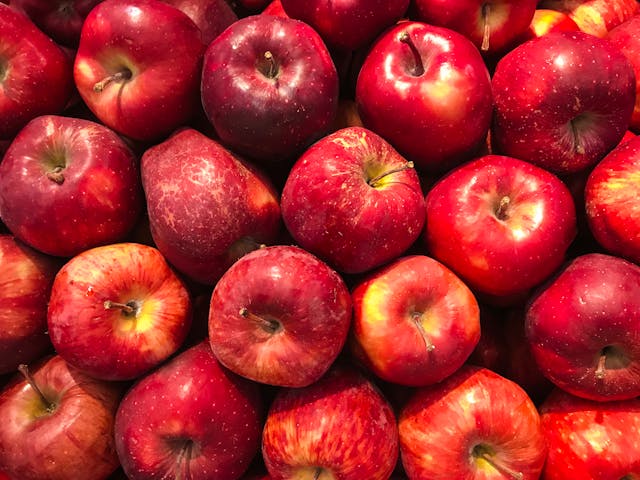Ensuring proper food storage is crucial to preserve freshness and prevent spoilage. Although refrigerators are convenient for preserving numerous food items, they may not always be the optimal choice for certain foods. In fact, some items can experience alterations in texture, flavor, or accelerated spoilage when subjected to the cold temperatures of the fridge. Here are 10 foods that should avoid being refrigerated:
10.Tomatoes
Tomatoes, renowned for their vibrant hue, succulent texture, and adaptable taste, hold a pivotal role in countless global cuisines. Despite their widespread appeal, many inadvertently compromise the quality of their tomatoes by storing them in refrigerators. In this article, we’ll uncover the rationale behind why refrigeration should be avoided for tomatoes and explore optimal storage practices to preserve their freshness and flavor.
A key reason to eschew refrigeration for tomatoes lies in the detrimental impact of cold temperatures on their flavor and texture. Tomatoes boast volatile compounds that contribute to their distinctive aroma and taste profile. Exposure to temperatures below 50°F (10°C) prompts the breakdown of these compounds, resulting in flavor loss and a lackluster, mealy consistency. Consequently, refrigerated tomatoes often lack the robust, sweet-tart taste and firm, juicy texture characteristic of their room-temperature counterparts.
9. Melons
Melons, with their succulent flesh and invigorating sweetness, epitomize the essence of summertime indulgence cherished worldwide. From the luscious watermelons to the fragrant cantaloupes, these vibrant fruits offer a symphony of flavors that tantalize the palate. Yet, despite their widespread appeal, many unknowingly compromise the flavor and texture of their melons by subjecting them to refrigeration. In this discourse, we delve into the secret to preserving the sweetness of melons, advocating for room temperature storage as the optimal approach to maintain their freshness and flavor.
Refrigeration poses a significant challenge to the flavor and texture of melons. The natural ripening process, essential for developing their distinctive sweetness, is impeded by cold temperatures. Refrigerated melons often lose their flavor potency and may succumb to a mealy or mushy texture, detracting from their characteristic juiciness and vibrancy. To savor the full essence of melons, it is imperative to store them at room temperature until they reach peak ripeness.
Furthermore, aside from considerations of flavor and texture, room temperature storage also safeguards the nutritional richness of melons. Laden with essential vitamins, minerals, and antioxidants such as vitamin C, vitamin A, potassium, and lycopene, melons are a treasure trove of health benefits. Exposure to cold temperatures can lead to nutrient degradation, compromising the fruit’s nutritional value. By opting for room temperature storage, one can ensure that melons maintain their nutritional integrity, offering optimal nourishment with each delectable bite.
8. Bread
Bread, a staple enjoyed worldwide for its delightful scent, soft texture, and culinary adaptability, is often mistakenly refrigerated in attempts to extend its shelf life. However, this practice can ironically hasten its deterioration. Let’s delve into why refrigeration is ill-advised for bread and explore optimal storage methods to preserve its freshness and taste.
Refrigeration should be avoided primarily because cold temperatures expedite the staling process. Staling, characterized by the gradual dryness and firmness of bread, occurs more swiftly in the fridge due to its low humidity environment. Exposure to cold air causes moisture to escape from the bread’s crumb, hastening its staleness beyond what would occur at room temperature.
Furthermore, refrigeration can compromise the bread’s flavor profile. Bread contains volatile compounds that contribute to its distinctive aroma and taste. However, when subjected to cold temperatures, these compounds degrade, resulting in a diminished flavor and a less satisfying culinary experience. Refrigerated bread often lacks the robust, yeasty aroma and nuanced taste associated with freshly baked loaves.
7. Coffee
Coffee, renowned for its aromatic richness and invigorating taste, holds a cherished place among millions worldwide. Whether one savors a bold espresso or a velvety latte, the essence of the brewing experience lies in the quality of the coffee. Nevertheless, many aficionados inadvertently undermine the freshness and flavor of their treasured beans by resorting to refrigeration for storage. Let’s explore why refrigeration is ill-suited for coffee preservation and delve into the optimal methods for maintaining its exquisite taste and aroma.
One of the foremost reasons refrigeration proves unsuitable for coffee storage lies in its adverse effect on moisture levels. Coffee beans possess a hygroscopic nature, readily absorbing moisture from their environment. Exposure to the humid conditions within a refrigerator can cause the beans to absorb excess moisture, resulting in a decline in flavor and aroma. Furthermore, moisture-laden beans are susceptible to mold and spoilage, ultimately diminishing the brewing experience.
Refrigerators harbor an array of odors emanating from various food items stored within them. Given the porous nature of coffee beans, they easily absorb these odors, thereby compromising their flavor integrity. Storing coffee in the refrigerator may lead to the beans absorbing off-flavors and aromas from neighboring foods, such as onions, garlic, or lingering meal remnants. Consequently, one’s morning cup of coffee may exhibit undesirable notes reflective of the refrigerator’s contents rather than the true essence of the coffee itself.
6. Peanut Butter
Peanut butter, prized for its velvety texture and robust nutty taste, holds a cherished spot in kitchens worldwide. From being spread on toast to blended into morning oatmeal or even used as a delightful dip for fresh produce, its versatility knows no bounds. Yet, the question often arises: should peanut butter find its home in the refrigerator to preserve its freshness? Let’s delve into why peanut butter flourishes at room temperature and why chilling it is unnecessary.
One of the key factors favoring room temperature storage for peanut butter is its consistency and ease of spreading. The natural oils present in peanuts lend peanut butter its smooth texture. However, subjecting it to cold temperatures in the refrigerator can cause these oils to solidify, rendering the spread hard and challenging to work with. Opting for room temperature storage ensures that peanut butter remains soft and effortlessly spreadable, guaranteeing a consistently delightful culinary experience.
Moreover, refrigeration can alter the flavor profile of peanut butter. Cold environments tend to mute its inherent nutty aroma and taste, resulting in a less vibrant spread. By storing it at room temperature, peanut butter retains its rich, full-bodied flavor, ensuring each bite bursts with delightful nuttiness. Whether savored on its own or incorporated into various recipes, peanut butter kept at room temperature offers a superior taste and overall enjoyment compared to its chilled counterpart.
5. Apples
Apples, renowned for their crisp bite and delightful sweet-tart taste, stand as a perennial favorite among fruits, relished throughout the year. Whether savored as a refreshing snack with the satisfying crunch of a Honeycrisp or baked into the comforting embrace of an apple pie, these versatile fruits offer a myriad of culinary pleasures. Surprisingly, refrigeration can compromise their flavor and texture, contrary to common belief. Let’s delve into why storing apples at room temperature is the superior method for preserving their freshness and taste.
One of the main drawbacks of refrigeration lies in its adverse effect on the texture of apples. These fruits boast a natural composition rich in sugars and water, which contribute to their crispness. However, exposure to cold temperatures within the confines of a refrigerator can induce the breakdown of apple cells, resulting in a less appealing, softer consistency. Refrigerated apples may relinquish their coveted crunch, diminishing their appeal whether consumed fresh or incorporated into various recipes.
Moreover, apples are particularly sensitive to ethylene gas, a naturally occurring plant hormone intricately involved in the ripening process. Like many other fruits, apples emit ethylene gas as they mature. Placing them in the refrigerator alongside ethylene-producing counterparts such as bananas or tomatoes can lead to the absorption of excess ethylene, hastening the ripening process and compromising their freshness prematurely. To safeguard against premature ripening and maintain optimal freshness, it’s advisable to store apples separately from ethylene-emitting fruits at room temperature.
4. Avocados
In recent years, avocados have surged in popularity, becoming a kitchen essential worldwide due to their creamy texture and buttery taste. Whether whipped into guacamole, layered on toast, or blended into salads and smoothies, avocados boast versatility and nutritional perks. Yet, a common query persists: should avocados be refrigerated? This piece delves into the rationale behind storing avocados outside the fridge and how maintaining them at room temperature can uphold their flavor, consistency, and nutritional value.
Avocados possess a unique trait—they continue to ripen post-harvest. The ripening process hinges on temperature, with avocados achieving optimal ripeness between 65°F to 75°F (18°C to 24°C). Refrigerating avocados can impede ripening, hindering them from attaining peak flavor and texture. Room temperature storage allows avocados to mature naturally, resulting in a luscious, buttery texture and a decadent, nutty taste.
Chilling avocados can compromise their texture, rendering them rubbery or mushy. Cold temperatures disrupt the cell composition of avocados, leading to undesirable alterations in texture. Conversely, storing them at room temperature preserves the integrity of their flesh, ensuring a velvety, creamy texture ideal for spreading, slicing, or mashing. Properly ripened avocados at room temperature provide an unparalleled mouthfeel and culinary experience.
3. Honey
Honey, with its radiant hue, delightful sweetness, and diverse applications, has been cherished by civilizations throughout history. Whether it’s adorning toast, enriching tea, or serving as a natural sweetener in recipes, honey stands as a versatile kitchen essential with an enduring shelf life. Yet, questions often arise about its storage, particularly regarding the necessity of refrigeration. Let’s delve into why honey flourishes sans refrigeration and uncover the best practices for preserving its flavor, texture, and nutritional integrity.
One of honey’s remarkable attributes lies in its innate resistance to spoilage. With its low water content and acidic pH levels, honey creates an environment hostile to microorganism growth, including bacteria and mold. These inherent preservation qualities render honey stable at room temperature, ensuring its freshness and safety for consumption without the need for refrigeration.
Refrigeration can detrimentally impact the texture and consistency of honey. Exposure to cold temperatures can prompt crystallization, resulting in a thick, grainy texture that diminishes its appeal. Storing honey at room temperature preserves its smooth, flowing consistency, guaranteeing easy pouring, drizzling, and spreading. Whether employed as a topping or an ingredient, room-temperature honey offers optimal texture and versatility.
2. Chocolate
Chocolate, with its luscious taste and smooth texture, is a universally adored indulgence cherished by people of all ages worldwide. Whether in the form of bars, truffles, or sumptuous desserts, chocolate tantalizes the palate and adds delight to any occasion. Yet, the debate over the optimal storage method for chocolate persists, with some advocating refrigeration to prevent melting and others recommending room temperature storage. Let’s delve into why chocolate thrives outside the fridge and how proper storage elevates its flavor, texture, and overall quality.
One compelling reason to store chocolate outside the fridge is to maintain its luxurious texture. Refrigeration can lead to the formation of a whitish film, known as “bloom,” caused by the separation of cocoa butter from cocoa solids and sugar. This bloom alters the texture, rendering chocolate dull and gritty instead of its desired smooth and glossy state. By storing chocolate at room temperature, its velvety texture and decadent mouthfeel are preserved, ensuring a delightful chocolate experience with every indulgent bite.
Beyond texture considerations, room temperature storage enhances chocolate’s flavor profile. Chocolate contains volatile flavor compounds susceptible to temperature fluctuations. Refrigeration can diminish the aromatic qualities of chocolate, resulting in a less vibrant and intense flavor. Conversely, storing chocolate at room temperature allows it to develop a full spectrum of flavors, ranging from deep cocoa notes to nuanced hints of fruit and nuts. This optimal storage condition provides a more satisfying and indulgent tasting experience, enhancing the enjoyment of chocolate aficionados everywhere.
1. Olive Oil
Dubbed as “liquid gold,” olive oil holds a revered status in Mediterranean cuisine and global kitchens alike. Renowned for its rich flavor, versatility, and health benefits, this culinary gem finds its way into countless recipes, from savory dishes to delightful dressings. Despite debates on refrigeration, the optimal storage of olive oil at room temperature is crucial to preserving its excellence in taste, fragrance, and nutritional value.
At room temperature, olive oil maintains its essence, safeguarding its distinctive flavor and aroma. Unlike refrigeration, which can induce cloudiness and solidification, compromising its visual appeal and consistency, storing olive oil at ambient temperature upholds its vibrant character. This approach allows the oil to retain its fruity scent, velvety texture, and robust taste, elevating the gastronomic experience with each dish.
Primarily composed of monounsaturated fats, olive oil remains in its liquid state when stored at room temperature, ensuring ease of use. Refrigeration, on the other hand, prompts solidification, resulting in a cumbersome, waxy texture that hinders pouring and application. By opting for room temperature storage, the oil remains effortlessly pourable and readily incorporable into recipes, obviating the need for pre-heating or warming procedures.









